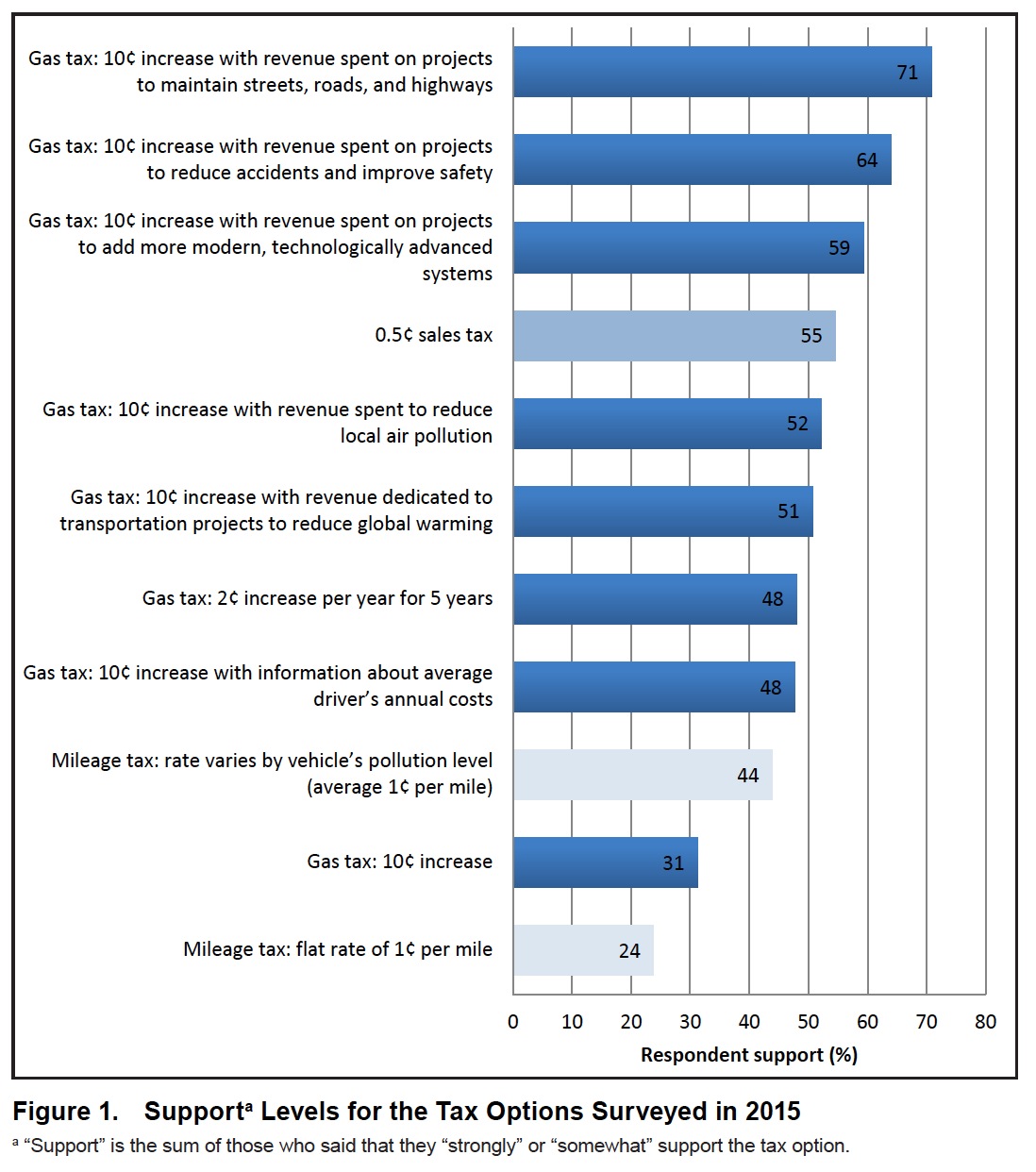MINETA TRANSPORTATION INSTITUTE
I. Introduction
Over the past several decades, the transportation revenues available from state and federal gas taxes have fallen significantly, especially in terms of inflation-adjusted dollars per mile traveled. At the same time, the transportation system requires critical—and expensive— system upgrades. Among other needs, a large portion of the national highway system requires major rehabilitation, and there is growing desire at all levels of government to substantially upgrade and expand infrastructure to support public transit, walking, and bicycling.
This dilemma of growing needs and shrinking revenues can be resolved in only two ways: either the nation must dramatically lower its goals for system preservation and enhancement, or new revenues must be raised. If the latter is to happen, legislators must be convinced that increasing taxes or fees is politically feasible. One portion of the political calculus that legislators make when deciding whether or not to raise new revenues is, of course, considering likely public support for—or opposition to—raising different kinds of taxes.
This report contributes to the understanding of current public sentiment about increasing transportation taxes by presenting the results from the sixth year of an annual telephone survey investigating public opinion about a variety of transportation tax options at the federal level. The specific taxes tested were ten variations on raising the federal gas tax rate or creating a new mileage tax, as well as one option for creating a new federal sales tax. In addition, the survey collected standard sociodemographic data, some travel behavior data, and respondents’ views on the quality of their local transportation system, and their priorities for government spending on transportation in their state. All of this information is used to assess support levels for the tax options among different population subgroups.
The survey questionnaire described the various tax proposals in only general terms, so the study results cannot be assumed to reflect support for any actual proposal put forward. Nevertheless, the results show likely patterns of support and, more important, the public’s likely relative preferences among different transportation tax options.
In the 2012 survey (the third year), questions were added to probe public perceptions related to public transit, including knowledge and opinions about federal taxes to support transit. Several new transit-related questions were added to explore respondents’ knowledge of whether different levels of government help to pay for transit, their opinion about whether gas tax revenues should be spent on transit, and their support for different Congressional options to raise additional revenues to support improved and expanded transit.
Because the survey is the sixth year of a project to assess how public support for federal transportation taxes may change over time, most of the questions are identical to those in the earlier surveys carried out in the five prior years.1 This report compares the results of the six surveys to establish how public views may have changed over the past years.
The remaining chapters of the report contain the following material. Chapter 2 describes findings from other polling on similar transportation taxes to provide context for understanding this survey’s results. Chapter 3 describes the survey methodology and presents an overview of the questionnaire and details of the implementation procedure.
…
Summary of Key Findings
Overall Support Levels for the 11 Tax Options in 2015
The survey results show that a majority of Americans would support higher taxes for transportation—under certain conditions. For example, a gas tax increase of 10 cents per gallon to improve road maintenance was supported by 71% of respondents, whereas support levels dropped to 51% if the revenues were to be devoted to reducing global warming or only 31% if the revenues were to support undefined transportation purposes. As for tax options in which the revenues were to be spent for undefined transportation purposes, support levels varied considerably by the kind of tax that would be imposed, with a sales tax much more popular (55%) than either a gas tax increase (31%) or a new mileage tax (24%).
A central goal of the survey was to compare public support for two alternative versions of the mileage tax and eight versions of a gas tax increase. Variations on the base cases increased support substantially over that for the base cases, which were a flat-rate mileage tax of 1 cent per mile and a 10-cent gas tax increase proposed without any additional detail. Those boosts in support for the variants on the base cases ranged from a low of 16 percentage points to a high of 40 points.
When interpreting the survey results, it is important to keep in mind that the questionnaire described the various tax proposals in only general terms, so the results cannot be assumed to reflect support for any actual proposal put forward. Nevertheless, the results show likely patterns of support and, more important, the public’s likely relative preferences among different transportation tax options.
About Mineta Transportation Institute
transweb.sjsu.edu
The Mineta Transportation Institute (MTI) conducts research, education, and information and technology transfer, focusing on multimodal surface transportation policy and management issues. It was established by Congress in 1991 as part of the Intermodal Surface Transportation Efficiency Act (ISTEA) and was reauthorized under TEA-21 and again under SAFETEA-LU. The Institute is funded by Congress through the US Department of Transportation’s (DOT) Research and Innovative Technology Administration, by the California Legislature through the Department of Transportation (Caltrans), and by other public and private grants and donations, including grants from the US Department of Homeland Security.
Tags: Mineta Transportation Institute, San Jose State University







 RSS Feed
RSS Feed